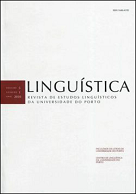Sibilants after sonorous consonants in Euskera: insertion vs. affrication, phonetics and phonology
Abstract
This paper deals with the Basque phonological process that affricates sibilant fricatives following sonorant consonants. The analysis of this process is particularly adequate for the discussion of the reciprocal relationship between phonetics and phonology as proposed by Natural Phonology. Within that theoretical framework, this study investigates the phonetic motivation of phonology; on the other hand, the perceptual –perhaps also productive– consequences of the language-specific phonemic systems are explored by comparing the Basque affrication process with the better known English process of stop insertion. It is argued that the terminological choice between affrication and insertion might not be a trivial issue, but the reflection of some difference in the phonological processing of basically equivalent phonetic conditions. The optimization of syllable structure is presented as another possible element in the shaping of the phonological process and an important factor of its relative relevance in typologically different languages. Some comments on spectrographic images are provided in section 3, in order to show the kind of observations that prompted this ongoing research.
References
Ali, L.; Daniloff, R.; Hammarberg, R. 1979. Intrusive stop in nasal-fricative clusters: an aerodynamic and acoustic investigation. Phonetica. 36: 85-97.
Álvarez-Enparantza, J. L. 1980. Euskal Fonologia. San Sebastián: Ediciones Vascas. Browman, C. P.; Goldstein, L. 1990. Tiers in articulatory phonology. In J. Kingston; M. E. Beckman (Eds.). Papers in Laboratory Phonology I. Between the Grammar and Physics of Speech. Cambridge University Press, 341-376.
Busà, M. G. 2007. Coarticulatory nasalization and phonological developments. Data from Italian and English nasal-fricative sequences. In: M. J. Solé; P. S. Beddor; M. Ohala (Eds.). Experimental Approaches to Phonology. Oxford: Oxford University Press, 155-191.
Camino, I. 2004. Nafarroa Behereko euskara. Fontes Linguae Vasconum. 97: 445- 486.
Clements, G. N. 1992. Phonological primes: features or gestures? Phonetica. 49: 181- 193.
Coyos, J. B. 1999. Le Parler Basque Souletin des Arbailles. Une approche de l’ergativité. Paris/Montréal: L’Harmattan.
Dinnsen, D. A. 1985. A re-examination of phonological neutralization. Journal of Linguistics 21: 265-279.
Donegan, P. 1993a. On the phonetic basis of phonological change. In. C. Jones (Ed.). Historical Linguistics. Problems and Perspectives. London: Longman, 98-130.
Donegan, P. 1993b. Rhythm and vocalic drift in Munda and Mon-Khmer. Linguistics of the Tibeto-Burman Area 16 (1): 1-43.
Donegan, P.; Stampe, D. 1978. The syllable in phonological and prosodic structure. In A. Bell; J. Bybee Hooper (Eds.). Syllables and Segments. Amsterdam: North- Holland Publishing Co, 25-34.
Donegan, P.; Stampe, D. 1979. The study of Natural Phonology. In: D. A. Dinnsen (Ed.). Current Approaches in Phonological Theory. Bloomington: Indiana University Press, 126-173.
Donegan, P.; Stampe, D. 1983. Rhythm and the Holistic Organization of Language Structure. In: J. Richardson et al. (Eds.). Papers from the Parasession on the Interplay of Phonology, Morphology, and Syntax. Chicago: CLS. University of Chicago, 337-353.
Donegan, P.; Stampe, D. 2004. Rhythm and the synthetic drift of Munda. In: R. Singh (Ed.). 2004 Yearbook of South Asian Languages and Linguistics. Berlin/New York: Walter de Gruyter, 3-36.
Donegan, P.; Stampe, D. 2009. Hypotheses on Natural Phonology. Poznan Studies in Contemporary Linguistics. 45 (1): 1-31. También en: http://phonology.wordpress. com.
Dressler, W. U. 1989 Towards a natural phonology of Hungarian. Acta Linguistica Hungarica 39(1-4): 29-51.
Fourakis, M.; Port, R. 1986. Stop epenthesis in English. Journal of Phonetics 14: 197- 221.
Hualde, J. I. 1991. Basque Phonology. London/New York: Routledge.
Hurch, B. 1988. Phonetics and Phonology or Phonology and Phonetics. ZPSK 41-3: 346-352.
Jakobon, R. 1968. Child Language, Aphasia and Phonological Universals. The Hague: Mouton.
Jauregi, O.; Oñederra, M. L. 2008. Africación de sibilante tras consonante sonante.
Phonetic Design. Granada: Universidad de Granada, 135-141.
Michelena, L. 1977. Fonética Histórica Vasca. San Sebastián: Seminario Julio de Urquijo de la Excma. Diputación de Guipúzcoa. [Reimpr. en 1985].
Murray, R. W. 1989. On epenthesis. Folia Linguistica 23 (3-4): 293-316. Ohala, J. 1981. Speech timing as a tool in phonology. Phonetica 38: 204-212.
Oñederra, M. L. 2009. Early bilingualism as a source of morphonological rules for the adaptation of loanwords: Spanish loanwords in Basque. In A. Calabrese; W. L. Wetzels (Eds.). Loan Phonology. Amsterdam/Philadelphia: John Benjamins, 193- 210.
Rotaetxe, K. 1978. Estudio Estructural del Euskera de Ondárroa. Durango: Leopoldo Zugaza.
Salaburu, P. 1984. Hizkuntzaren Soinu Egitura. Bilbao: UPV-EHU.
Stampe, D. 1979. A Dissertation on Natural Phonology. New York:Garland/ Bloomington: Indiana University Linguistics Club.
Schwarz, G. 2003. Palatalization in Common Slavic –an experimental approach. Folia Lingüística Historica 24 (1-2): 267-276.
Vennemann, Theo. 1988. Preference Laws for Syllable Structure and the Explanation of Sound Change. Berlin/New York/Amsterdam: Mouton de Gruyter.
Zwicky, A. M. 1972. Note on a phonological hierarchy in English. In R. P. Stockwell; R. K. S. Macaulay (Eds.). Linguistic Change and Generative Theory. Bloomington: Indiana University Press, 275-301.
Downloads
Published
Issue
Section
License
Copyright (c) 2017 Linguística Revista de Estudos Linguísticos da Universidade do Porto

This work is licensed under a Creative Commons Attribution-NonCommercial 4.0 International License.



